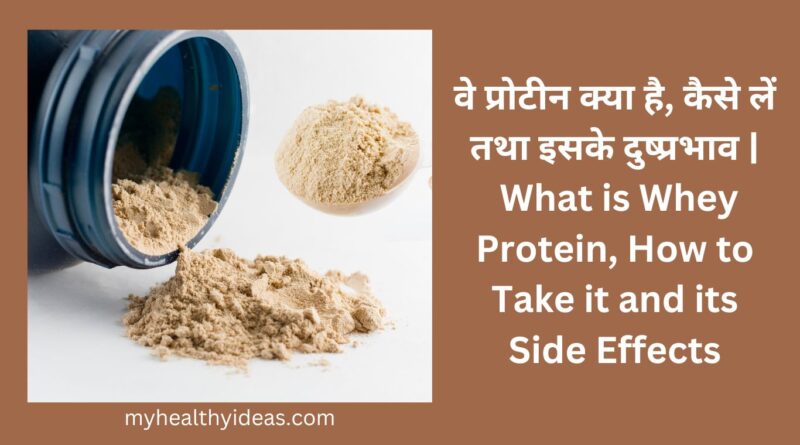वे प्रोटीन क्या है, कैसे लें तथा इसके दुष्प्रभाव | What is Whey Protein, How to Take it and its Side Effects
Table of Contents
वे प्रोटीन क्या है, कैसे लें तथा इसके दुष्प्रभाव
वे प्रोटीन एक लोकप्रिय आहार है जो आमतौर पर उन व्यक्तियों द्वारा उपयोग किया जाता है जो अपने प्रोटीन का सेवन बढ़ाना चाहते हैं, विशेष रूप से एथलीट, तगड़े लोग, और जो तीव्र शारीरिक गतिविधियों में संलग्न हैं।
यह पनीर बनाने की प्रक्रिया के दौरान दूध से प्राप्त होता है। मट्ठा प्रोटीन को एक पूर्ण प्रोटीन माना जाता है क्योंकि इसमें मानव शरीर के लिए आवश्यक सभी आवश्यक अमीनो एसिड होते हैं।
वे प्रोटीन के तीन मुख्य प्रकार हैं:
वे प्रोटीन कन्सनट्रेट:
यह Whey प्रोटीन का सबसे सामान्य रूप है। यह न्यूनतम प्रसंस्करण से गुजरता है, लैक्टोज और वसा की थोड़ी मात्रा को बनाए रखता है। वे प्रोटीन कन्सनट्रेट में आमतौर पर लगभग 70-80% प्रोटीन होता है, साथ में कुछ कार्बोहाइड्रेट और वसा भी होते हैं।
वे प्रोटीन आइसोलेट:
वे प्रोटीन का यह रूप अधिकांश लैक्टोज, वसा और कार्बोहाइड्रेट को हटाने के लिए अतिरिक्त प्रसंस्करण से गुजरता है। वे प्रोटीन आइसोलेट आमतौर पर प्रोटीन सामग्री में 90-95% से अधिक होता है। यह उन व्यक्तियों के लिए एक लोकप्रिय विकल्प है जो लैक्टोज असहिष्णु हैं या कम कार्बोहाइड्रेट आहार का पालन कर रहे हैं।
वे प्रोटीन हाइड्रोलाइज़ेट:
यह वे प्रोटीन का सबसे व्यापक रूप से संसाधित रूप है। यह पहले से पचा हुआ या हाइड्रोलाइज्ड होता है, प्रोटीन को छोटे पेप्टाइड्स में तोड़ देता है, जिसे शरीर द्वारा अधिक तेजी से अवशोषित किया जा सकता है। वे प्रोटीन हाइड्रोलाइज़ेट का उपयोग अक्सर इसकी त्वरित अवशोषण दर के कारण विशेष खेल पोषण उत्पादों में किया जाता है।
वे प्रोटीन कैसे लेते है?
वे प्रोटीन लेने के लिए, आप इसे पानी, दूध या अपनी पसंद के पेय के साथ मिला सकते हैं। विशिष्ट खुराक और समय आपके व्यक्तिगत लक्ष्यों और पोषण संबंधी आवश्यकताओं पर निर्भर करता है।
बहुत से लोग वे प्रोटीन का सेवन कसरत के बाद के शेक के रूप में करते हैं ताकि मांसपेशियों की रिकवरी और वृद्धि में सहायता मिल सके। हालाँकि, इसे भोजन के बीच या संतुलित आहार के हिस्से के रूप में प्रोटीन पूरक के रूप में भी लिया जा सकता है।
वे प्रोटीन के दुष्प्रभाव
जबकि वे प्रोटीन आम तौर पर खपत के लिए सुरक्षित है, इसके संभावित दुष्प्रभावों के बारे में पता होना महत्वपूर्ण है:
पाचन संबंधी समस्याएं:
लैक्टोज असहिष्णुता या प्रोटीन के प्रति संवेदनशीलता के कारण कुछ व्यक्तियों को पाचन संबंधी असुविधा का अनुभव हो सकता है, जैसे सूजन, गैस या दस्त।
एलर्जी प्रतिक्रियाएं:
वे प्रोटीन दूध से प्राप्त होता है, इसलिए दूध से एलर्जी वाले व्यक्तियों को इससे बचना चाहिए। एलर्जी प्रतिक्रियाओं में पित्ती, खुजली, सूजन या सांस लेने में कठिनाई शामिल हो सकती है।
गुर्दा तनाव:
वे प्रोटीन सहित उच्च प्रोटीन का सेवन, विशेष रूप से पहले से मौजूद गुर्दे की स्थिति वाले व्यक्तियों में गुर्दे पर दबाव डाल सकता है। यदि आपको गुर्दे की समस्या है तो स्वास्थ्य देखभाल पेशेवर से परामर्श करने की सलाह दी जाती है।
मौजूदा स्थितियों या दवाओं के साथ हस्तक्षेप:
यदि आपके पास कोई पूर्व-मौजूदा चिकित्सा स्थिति है या दवाएं ले रहे हैं, तो यह सुनिश्चित करने के लिए कि यह आपके लिए सुरक्षित है, वो प्रोटीन पूरकता शुरू करने से पहले एक स्वास्थ्य देखभाल पेशेवर से परामर्श करना महत्वपूर्ण है।
याद रखें, वो प्रोटीन एक पूरक है और इसका उपयोग संतुलित आहार के विकल्प के रूप में नहीं किया जाना चाहिए। अपनी दिनचर्या में किसी भी नए आहार पूरक को शामिल करने से पहले स्वास्थ्य देखभाल पेशेवर या पंजीकृत आहार विशेषज्ञ से परामर्श करना हमेशा एक अच्छा विचार है।
What is Whey Protein, How to Take it and its Side Effects
Whey protein is a popular dietary supplement commonly used by individuals looking to increase their protein intake, particularly athletes, bodybuilders, and those engaging in intense physical activities.
It is derived from milk during the cheese-making process. Whey protein is considered a complete protein as it contains all essential amino acids required by the human body.
There are three main types of whey protein:
Whey Protein Concentrate (WPC):
This is the most common form of whey protein. It undergoes minimal processing, retaining a small amount of lactose and fat. WPC typically contains around 70-80% protein, along with some carbohydrates and fats.
Whey Protein Isolate (WPI):
This form of whey protein undergoes additional processing to remove most of the lactose, fat, and carbohydrates. WPI is generally higher in protein content, ranging from 90-95%. It is a popular choice for individuals who are lactose intolerant or following a low-carbohydrate diet.
Whey Protein Hydrolysate (WPH):
This is the most extensively processed form of whey protein. It is predigested or hydrolyzed, breaking down the proteins into smaller peptides, which can be absorbed more rapidly by the body. WPH is often used in specialized sports nutrition products due to its quick absorption rate.
To take whey protein, you can mix it with water, milk, or a beverage of your choice. The specific dosage and timing depend on your individual goals and nutritional needs.
Many people consume whey protein as a post-workout shake to aid in muscle recovery and growth. However, it can also be taken as a protein supplement between meals or as a part of a balanced diet.
Side Effects:
While whey protein is generally safe for consumption, it’s important to be aware of potential side effects:
Digestive Issues:
Some individuals may experience digestive discomfort, such as bloating, gas, or diarrhea, due to lactose intolerance or sensitivities to the protein itself.
Allergic Reactions:
Whey protein is derived from milk, so individuals with milk allergies should avoid it. Allergic reactions can include hives, itching, swelling, or difficulty breathing.
Kidney Strain:
High protein intake, including whey protein, may put strain on the kidneys, particularly in individuals with pre-existing kidney conditions. It is advisable to consult with a healthcare professional if you have kidney problems.
Interference with Existing Conditions or Medications:
If you have any pre-existing medical conditions or are taking medications, it’s important to consult with a healthcare professional before starting whey protein supplementation to ensure it is safe for you.
Remember, whey protein is a supplement and should not be used as a substitute for a balanced diet. It’s always a good idea to consult with a healthcare professional or a registered dietitian before incorporating any new dietary supplements into your routine.



